How to Build a Raised Garden Bed
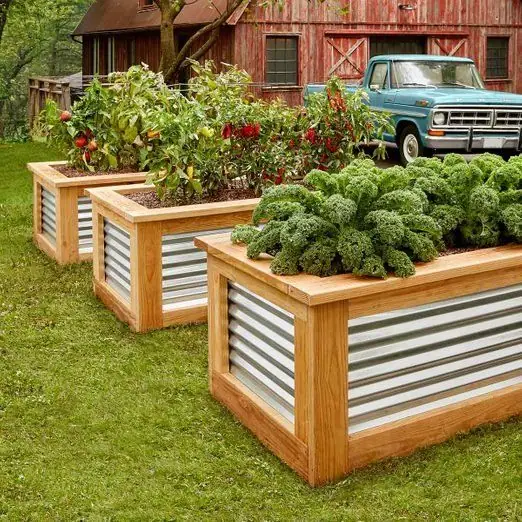
Have you ever wondered how to build a raised garden bed? Do you have any plans for a raised garden bed in your backyard? In this article, you will find all the necessary steps to build a raised garden bed in numerous different styles and techniques.
If the conditions in your backyard are not ideal for growing plants (the soil is either hard or rocky), they will be an excellent addition to your garden. They might brighten up your backyard with various colors of beautiful flowers or grow multiple kinds of vegetables and herbs. Building beds is also an exciting spring DIY project in itself.

Benefits and Drawbacks
Better soil for your plants. With the plants being separated from the rest of the garden floor, you will never step on young plant buds. Walking and stepping on the soil also compresses the dirt and thus can be detrimental to the plants. By keeping yourself in the aisles, you will help the soil keep loose, which will provide space for seeds to grow and make it easier to remove the weeds.
What’s more, you will also be able to choose the type of soil that is best for your plants: some of them might need it hard and rocky, while others prefer soft, damp dirt.
Less maintenance over the years. You will be able to keep the beds mulched all year round which will reduce the number of weeds. Also, they can help prevent erosion of the soil in your backyard because of much better drainage.
Easier gardening. The beds warm up early in the spring and this will give you an opportunity for a longer growing season. They will also be good for your back and knees since you won’t have to bend and kneel as much. You will also have an easier time planting and rotating crops each year.
More attractive garden. Permanent raised garden beds will give your backyard an organized feel and give it layers. These are great for the appearance of your vegetable garden since truck farms tend to look a bit stale. There are many ways to improve the look of the garden: paint the frames in various colors and patterns or use unique materials to introduce interesting textures. You can also make beds vary in height to introduce some asymmetry.
There are some important steps that are required for building any raised garden bed. Study our instructions carefully for a raised garden bed, and you will easily be able to build one yourself.
Things to Think About Before You Begin
There are a few things to consider before you start building the beds. Be sure to make up your mind which of the options suits you best:
Sunlight
Ideally, your plants should get 8 hours of sunlight in the middle of summer. You can try to expose them to even more sunlight, but if you live in an area with extremely high temperatures and humid air, that might be a bad idea. If that’s your case, you might even need to make plans to provide shade for your plants since they can dry up in the extreme heat waves even if you water them regularly.
Soil
Soil is as important as sunlight when it comes to growing plants. Each plant on this plant grows best in certain conditions that are unique to it. First, you should do a soil test to get a picture of what lies in your backyard. Collect a few samples around your garden and send them to a local lab for analysis. You should get the results in a few weeks. The test will give you all the necessary characteristics of your soil, like its levels of potassium, nitrogen, phosphorus, and any organic matter as well as its pH scale.
The lab might also give you recommendations on what to add to your soil based on the results of the test. If the quality of the soil is too low, you can also buy the one that will be better for your plants online or in your local nursery or cooperative extension service office. If you live in an older house with lead paint or near any heavy industry (like manufacturing plants, landfills, dry cleaners, gas stations), you should simply buy the soil and skip the tests to save money.
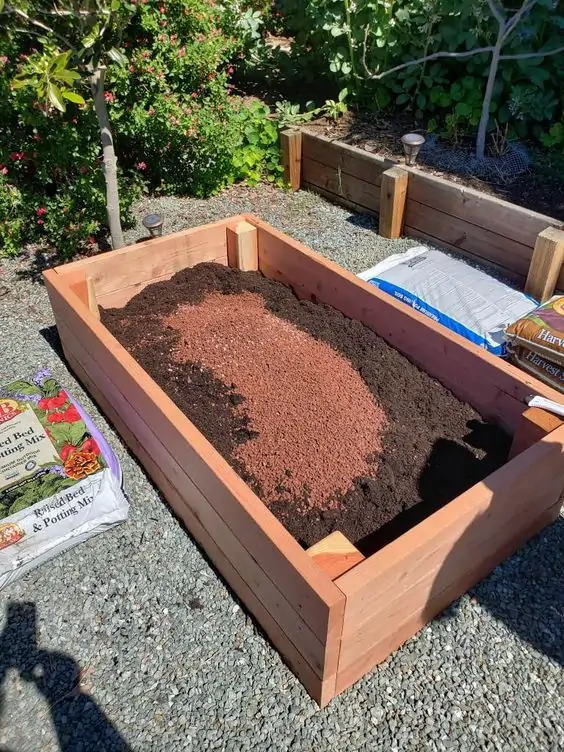
Size of the Beds
Gardening is a hobby that requires a significant investment of time and work. It can be very fun and rewarding, but that doesn’t make it less of a commitment. It can be tough at times, especially if you are new to it, so it is usually suggested that you start small. Build a small garden that is manageable and won’t get out of control when the season comes. Two or three beds will be more than enough if you are just getting started. If you are having fun and want to challenge yourself a bit more, add additional beds between the harvesting seasons. When you get more experienced, you will be able to manage hundreds of square feet of garden beds with different plant varieties.
Location
When you are deciding where to build a garden on your property, placing it close to your house is the best option. When you walk by your plants every morning of every day, it reminds you to check on them and water them regularly. That’s why you should never put them in the corner of your backyard.
Plus, by placing them near the house you will decorate the otherwise boring walls and be able to see the fruits of your labor from your patio, deck, or through the windows of your house. What’s more, be sure to build the beds on the most level part of your backyard, as it will make the installation much easier.
Materials and Supplies
If you have plans to make raised garden beds, you should know they are inexpensive and easy to build. You don’t need to use fancy and hard-to-get materials to build a long-lasting and functioning garden.
Old wooden beams and planks, stones, concrete blocks, and bricks should be more than enough to make the frames for the beds. You will need mulch for the paths. Wooden chips are a great option, but you will need to add a new layer each year, so it might get expensive.
Gravel, stones, and paver are good alternatives. When it comes to the mulch for the beds, chips of wood are a terrible option since they are carbonaceous, meaning they will steal nitrogen and other nutrients from the soil.
That’s why you should use something like hay, straw, leaves, grass, or other organic matter. Buy essential gardening tools and high-quality organic fertilizer, and you are ready to start growing your plants.
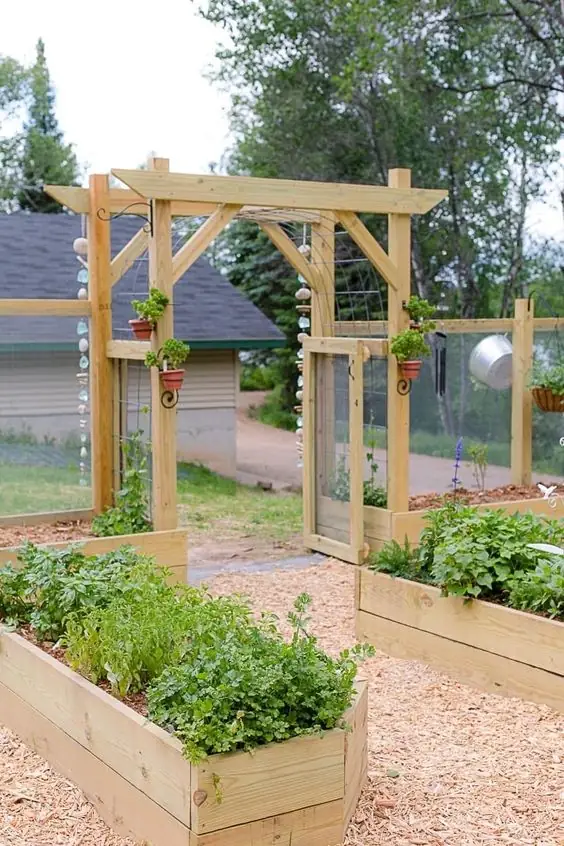
Plans and Designs
There are many different styles and designs of raised garden beds, each one with something unique about it. All of them are pretty easy to build; still, some have a few peculiarities you should pay close attention to when constructing. Here are some DIY raised garden bed ideas.
DIY Raised Garden Bed With Legs
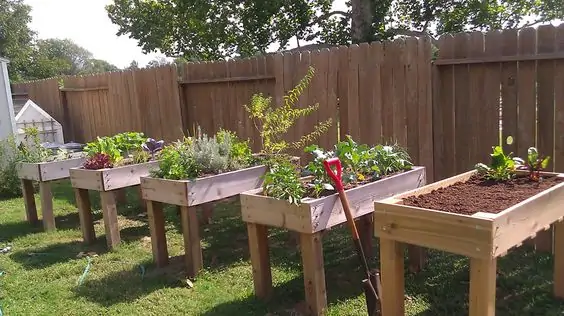
If you have back problems yet want to enjoy gardening, this can be a brilliant solution for you. With the beds being this high, you will rarely ever have to bend. Such a design will also provide you with a lot of free space under the beds where you can put your gardening tools, fertilizers, soil, and whatnot.
First, make sure to level the ground so that the beds don’t shake and wobble while you attend to the plants. Use treated wood for the frame and the legs of the beds. If you choose to use untreated wood, coat them in wood varnish to make them water- and mold-resistant. Make the frame with four 2” x 6’” pieces and connect them with nails and screws. Be sure to leave small gaps between the planks to allow the water to drain.
Then attach four posts to the bottom of the frame with galvanized screws. Add a thin sheet of plywood to the bottom and cover it with nylon. Lay a layer of mulch in the beds and add the desired soil. Plant any kind of vegetable or flower that has a short root, and you are good to go.
DIY Raised Garden Bed Cedar
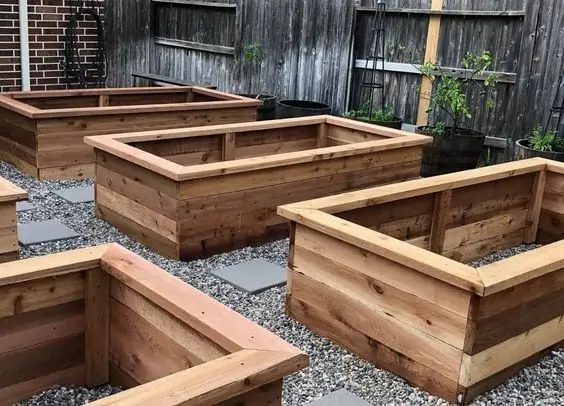
If you have any plans to build a wooden bed, cedar is a great choice. It is both affordable and easy to work with. You can make the beds as high as you want, but keep in mind you will need significantly more material and soil if you make them higher.
Beds of this kind will last a long time and won’t require much maintenance: just make sure you give them a fresh layer of finish every other year. The upfront cost of supplies and materials can be pretty high, so make sure your budget is big enough. If you are not so skilled in carpentry, you should probably build rectangular or square-shaped beds, but if you are up for a challenge, you can try making oval and circular ones.
First, determine the size of the beds. The most common choice of width is 4 feet, and the typical length is between 4 and 12 inches. Get 2” x 6” planks and connect them with stainless nails. If you opt to make the bed longer than 8 feet, you should add a 2” x 2” in the middle of each long side of the frame for extra stability and strength.
Add the posts in the corners to make the frame more rigid. They should be a bit higher than the rest of the frame, so they can go deeper into the ground for additional stability. Remove the grass from the desired location and dig shallow holes for the frames. Make sure there are no active anthills in the area that will mess up your plans. If there are any, buy an organic pesticide or deterrent for the ants. Lay the mulch in and around the frames. Fill them with soil and plant whatever kind of plant you want.
Reusing Old Pallets for Planters
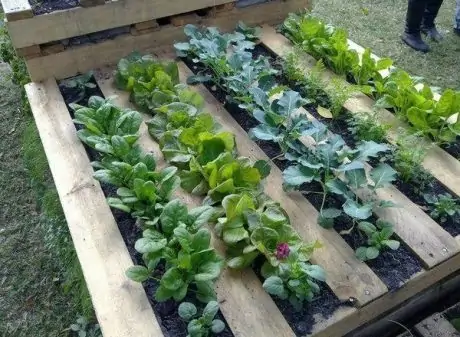
This will be a perfect option for any gardener who plans to make something more creative. Cut and join the pallets in any way you want, just make sure you leave enough space for the plants to grow and spread their roots. Grind the pallets on the sides that are exposed to the air and apply a water-repellent coating to prevent mold from growing.
Build a Raised Bed with a Circular Slope
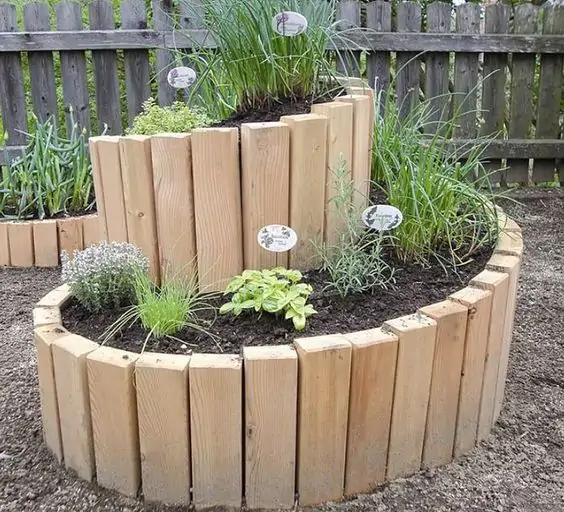
A circular sloped bed is a nice way to bring some asymmetry to your backyard. It’s also really easy to make. All you need is a bunch of wooden or metal posts arranged in 2 or more circles, each one taller than the previous one.
Leave small gaps between them to allow for drainage. Add soil with good nutrients and plant your flowers, preferably more than one kind to bring different colors and shapes to your house and backyard.
Tiered Raised Garden Bed for your Patio
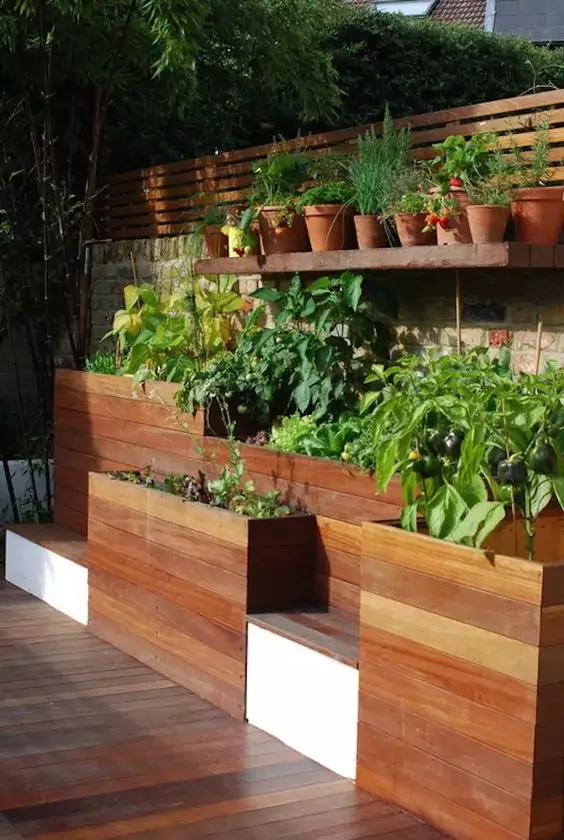
If you have plans to improve the look of your patio, add a tiered bed to one side of it. It will also give you easy access to your plants. Make the levels vary in height and add horizontal planks in unused areas of the bed to make benches that will allow you to take breaks while also acting as a place to put your gardening equipment while working.
Portable Planter Box for Your Deck
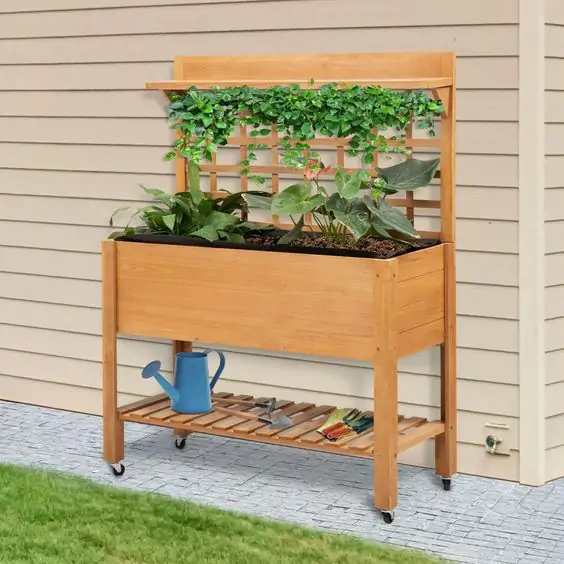
If you want to grow flowers and herbs on your deck but you don’t want to use boring plant pots, this might be a great solution for you. Make a light wooden planter box and add wheels to it. You will be able to move the box around, which means you can maximize the hours of sunlight your plants will get every day.
You might also want to add a shelf so that you can have your most useful gardening tools close at hand at all times.
Build Raised Planters with Protective Covering
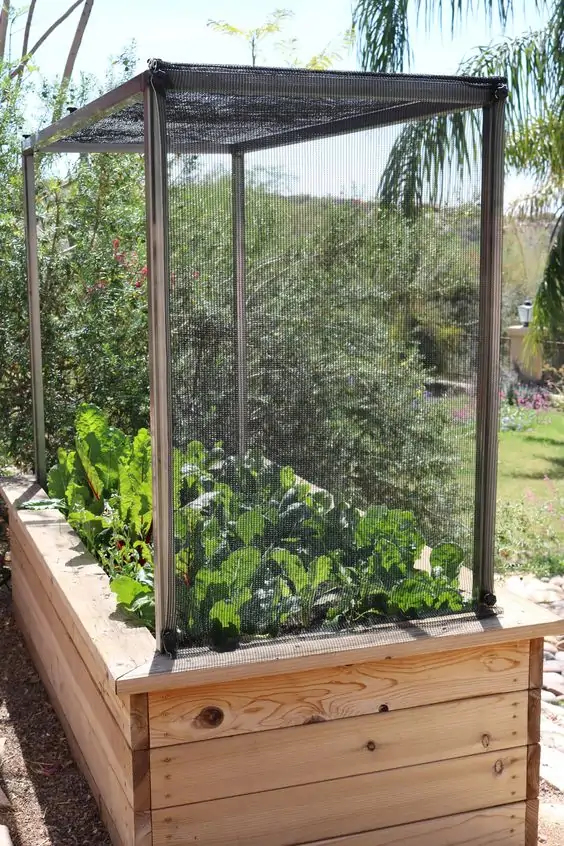
If you worry that hail and heavy rain might damage your plants, you can always add a protective covering. You can use hail netting, a stronger and more resilient version of mosquito nets, and attach it with screws. Add metal posts and beams and wrap the netting all around them. Not only will this stop the hail from ruining your hard work, but it also stops insects and other pests from eating your plants.
Unique Patterns
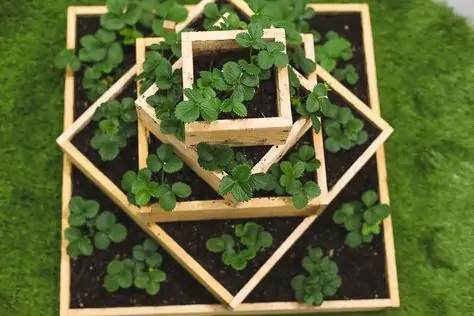
If you are skilled at carpentry and want to challenge yourself, try making a raised bed with a unique pattern. First, draw the plans for your beds on a piece of paper. It can be whatever you want, a combination of squares and triangles, various bending shapes, or you can make a number of small hexagons and fill them with beautiful flowers to make your backyard look like a giant beehive.
Raised Planters With Trellis
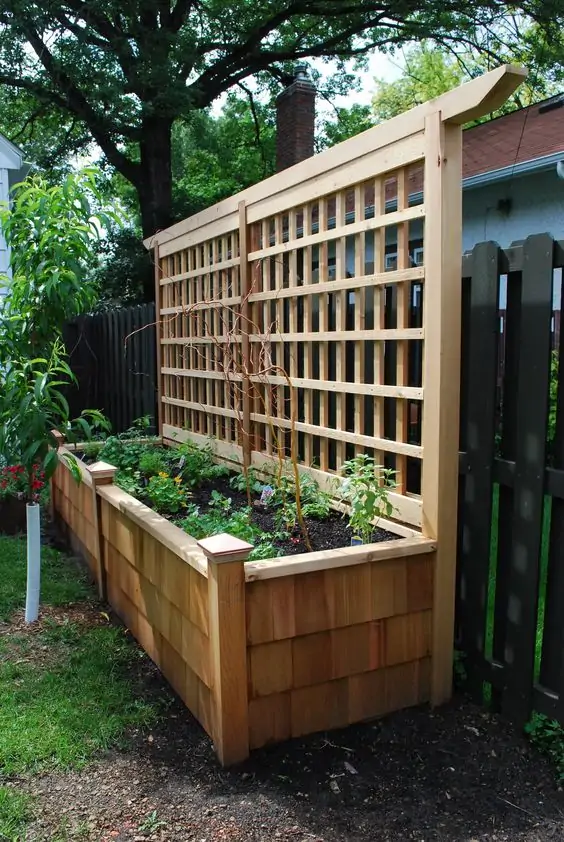
If you have any plans to grow tomatoes, grapes, or any other hanging plant, you will have to add a trellis to your raised bed. It can be made of wooden planks or strong galvanized metal mesh. Attach it to the posts that are extending from the frame. You can make the trellis as high as you want; just make sure it is strong enough to resist the strong winds.
Only start your work after you have read and understood every step and suggestion in this article. Get creative and come up with new ideas and ways to build raised garden beds in your backyard and make them truly unique. Hopefully, now you know how to build a raised garden bed in your backyard. Good luck with your DIY plans for a raised garden bed, and see you soon!